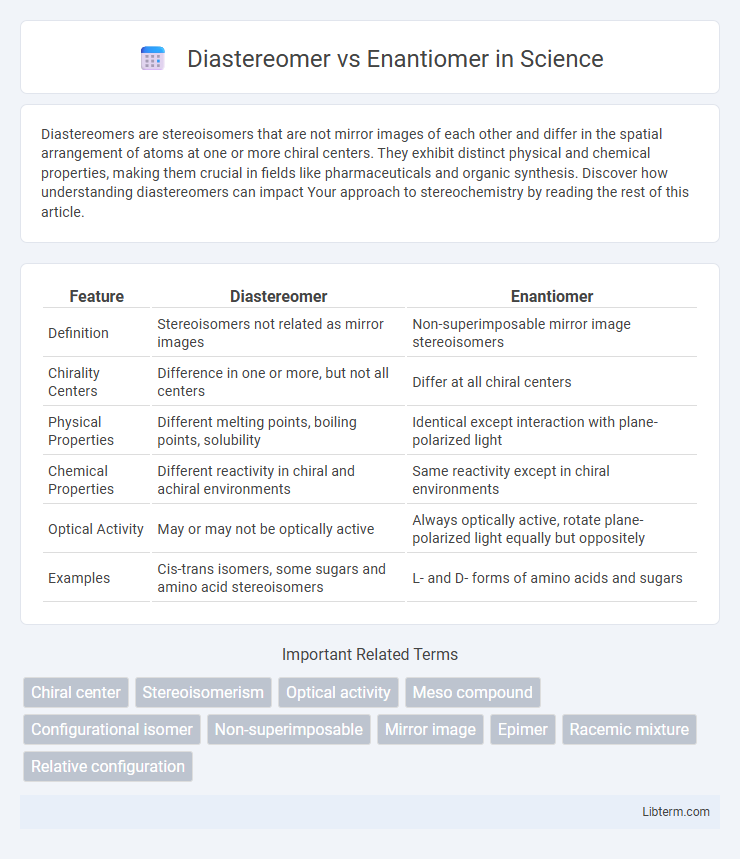Diastereomers are stereoisomers that are not mirror images of each other and differ in the spatial arrangement of atoms at one or more chiral centers. They exhibit distinct physical and chemical properties, making them crucial in fields like pharmaceuticals and organic synthesis. Discover how understanding diastereomers can impact Your approach to stereochemistry by reading the rest of this article.
Table of Comparison
| Feature | Diastereomer | Enantiomer |
|---|---|---|
| Definition | Stereoisomers not related as mirror images | Non-superimposable mirror image stereoisomers |
| Chirality Centers | Difference in one or more, but not all centers | Differ at all chiral centers |
| Physical Properties | Different melting points, boiling points, solubility | Identical except interaction with plane-polarized light |
| Chemical Properties | Different reactivity in chiral and achiral environments | Same reactivity except in chiral environments |
| Optical Activity | May or may not be optically active | Always optically active, rotate plane-polarized light equally but oppositely |
| Examples | Cis-trans isomers, some sugars and amino acid stereoisomers | L- and D- forms of amino acids and sugars |
Introduction to Stereochemistry
Stereochemistry explores the spatial arrangement of atoms in molecules, where diastereomers are stereoisomers that are not mirror images, differing in physical and chemical properties. Enantiomers, on the other hand, are non-superimposable mirror images with identical physical properties but opposite optical activities. Understanding the distinction between diastereomers and enantiomers is crucial for applications in pharmaceuticals, materials science, and molecular biology.
Defining Diastereomers
Diastereomers are stereoisomers that are not mirror images of each other and differ in the spatial arrangement at one or more stereocenters, but not all. Unlike enantiomers, which are non-superimposable mirror images, diastereomers exhibit distinct physical and chemical properties such as melting points and optical activities. Understanding diastereomers is essential in stereochemistry for predicting isomer behavior in chemical reactions and pharmaceutical applications.
Understanding Enantiomers
Enantiomers are a type of stereoisomer characterized by non-superimposable mirror images, differing in the spatial arrangement around a chiral center, which results in distinct optical activities. These molecules have identical physical properties except for the direction they rotate plane-polarized light and their interactions with other chiral substances. Unlike diastereomers, which have multiple stereocenters and different physical properties, enantiomers exhibit identical melting points and boiling points but differ significantly in biological activity and pharmacological effects.
Key Differences: Diastereomers vs Enantiomers
Diastereomers are stereoisomers that are not mirror images of each other and have different physical properties such as melting points and solubility, while enantiomers are non-superimposable mirror images with identical physical properties except for the direction in which they rotate plane-polarized light. Diastereomers differ in configurational arrangement at one or more, but not all, stereocenters, leading to variations in chemical reactivity, whereas enantiomers differ at all stereocenters and exhibit identical reactivity in achiral environments. The distinction between diastereomers and enantiomers is crucial for predicting stereochemical outcomes in synthesis and understanding chiral interactions in biological systems.
Molecular Symmetry and Chirality
Diastereomers exhibit different molecular symmetry and have at least one chiral center but differ in configuration at other centers, leading to non-mirror image stereoisomers. Enantiomers are pairs of molecules that are non-superimposable mirror images, characterized by identical molecular symmetry except for opposite chirality at all chiral centers. Chirality plays a critical role in distinguishing these stereoisomers, with enantiomers showing opposite optical activity while diastereomers often display different physical and chemical properties.
Physical and Chemical Properties Comparison
Diastereomers exhibit different physical properties such as melting points, boiling points, and solubilities, while enantiomers generally share identical physical properties except for their optical rotation direction. Chemically, diastereomers react differently with other chiral and achiral substances, whereas enantiomers have identical reactivity in achiral environments but differ in chiral interactions, particularly in biological systems. The distinct physical and chemical behavior of diastereomers aids in their separation, unlike enantiomers, which often require chiral agents or environments for differentiation.
Methods of Identification and Separation
Diastereomers can be identified and separated using techniques such as chromatography, including high-performance liquid chromatography (HPLC) and gas chromatography (GC), due to their different physical and chemical properties. Enantiomers require chiral methods like chiral chromatography or polarimetry for identification, as they have identical physical properties except for optical rotation. Separation of enantiomers often involves chiral stationary phases, enzymatic resolution, or diastereomeric salt formation to exploit their stereochemical differences.
Real-World Examples in Chemistry and Biology
Diastereomers, such as glucose and galactose, differ in their spatial arrangement at one or more chiral centers and exhibit distinct physical and chemical properties, impacting carbohydrate metabolism and sweetness perception. Enantiomers, like the drug thalidomide, are non-superimposable mirror images with identical physical properties except for their interaction with plane-polarized light and biological receptors, where one enantiomer may be therapeutic while the other is harmful. Real-world biological processes, including enzyme specificity and drug efficacy, rely heavily on the stereochemical differences between diastereomers and enantiomers to differentiate their physiological effects.
Importance in Pharmaceuticals and Drug Design
Diastereomers and enantiomers exhibit distinct three-dimensional arrangements that critically influence drug efficacy and safety in pharmaceuticals. Enantiomers often display significantly different pharmacodynamics and pharmacokinetics, necessitating chiral purity in drug formulations to minimize adverse effects and optimize therapeutic outcomes. Diastereomers, with their varied physical and chemical properties, enable selective targeting and improved drug stability, playing a vital role in structure-activity relationship studies during drug design.
Summary and Key Takeaways
Diastereomers are stereoisomers that are not mirror images and differ in physical and chemical properties, while enantiomers are non-superimposable mirror images with identical properties except for their interaction with polarized light and chiral environments. Diastereomers have multiple stereocenters and differ at one or more but not all chiral centers, whereas enantiomers differ at all chiral centers. Understanding the distinction is crucial in pharmaceuticals, as enantiomers can have drastically different biological activities, while diastereomers often show varying physical properties important for separation and characterization.
Diastereomer Infographic

 libterm.com
libterm.com